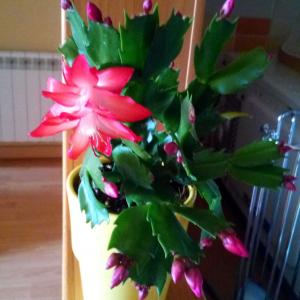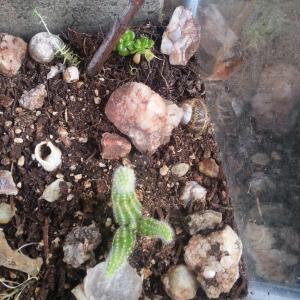成长记
giwilorjelly
2017年09月07日

I new added a "cactus 1" in my "garden"
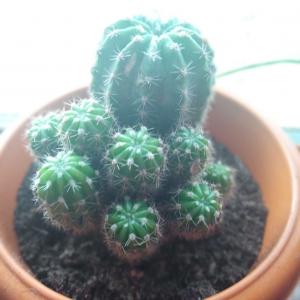

0
0
giwilorjelly:idk what species is this (bad with names) please help
Missysunflo
2017年08月30日

Trying something new trying to propagate a snake plant and a Christmas cactus😊




1
0
文章
Dummer. ゛☀
2017年08月27日

Holiday cacti bloom around the season for which they are named. Therefore, it comes as no surprise that the Thanksgiving cactus blooms around November. The Thanksgiving holiday cactus is an easy to grow interior plant. Both Christmas and Thanksgiving cacti are in the genus Schlumbergera and are native to the tropical forests of Brazil. They are attractive plants commonly sold and given as gifts around the holidays but are also easy to propagate from stem cuttings. Read on for Thanksgiving holiday cactus information that will keep you growing and giving away these plants for a lifetime.
Thanksgiving Cactus Information
Schlumbergera truncata is the Thanksgiving cactus. It is called a leaf cactus but is not a true cactus. Rather it is an epiphyte, those plants which live on other plants. The leaves are broad and flat with slight serrations on the edges in the Thanksgiving vs. Christmas cactus, which has smoother edges. The flowers that appear in fall are similar to fuchsia blooms and come in hues of yellow, white, pink and red.
These plants are classed as Zygocactus, which some scholars call a misnomer, while others shout it from the roof tops. Whatever type of plant it is, the Thanksgiving holiday cactus is a proven winner, with blooms that last for 2 to 4 months and an easy-going nature. The only real problem with the plant is its need to be fooled in order to bloom again the next year.
Forcing Thanksgiving cactus to bloom requires cool temperatures and shorter daylight hours. That means if you live in a region with no frost, you can leave the cactus outside to experience just what is naturally occurring. Those of us who live where temperatures get cold will have to create false conditions indoors to protect them from the cold, but can experience cool temps down to 40 degrees Fahrenheit (4 C.) and reduced light, including artificial light. Start forcing Thanksgiving cactus to bloom in late summer to early fall.
Thanksgiving Cactus Plant Care
One of the most crucial aspects of Thanksgiving cactus plant care is water. These tropical plants should not be allowed to dry out; however, excess water at the roots can cause rotting and fungal issues. As an epiphyte, it often has exposed roots and gathers most of its moisture through humidity in the air. Potted plants need well-draining soil and good drainage. Water thoroughly and then allow the top 1/3 of soil dry out before you water again.
Growing Thanksgiving Cactus Cuttings
The plants are easy to propagate and multiply. Snip off a stem with 4 to 5 sections and leaves. Dust the end with fungicide and allow it to callus for a week in a dry location. Fill a small clay pot with vermiculite or perlite mixed with potting soil. Alternatively, you can use damp sand. Push the callused end into the mixture and place the pot in bright but indirect light. Tent over the cutting with a plastic bag and remove it for an hour each day to let in air. In approximately 3 weeks, the cutting will have rooted and you will have a brand new plant. Growing Thanksgiving cactus to blooming stage will take a couple of years.

Thanksgiving Cactus Information
Schlumbergera truncata is the Thanksgiving cactus. It is called a leaf cactus but is not a true cactus. Rather it is an epiphyte, those plants which live on other plants. The leaves are broad and flat with slight serrations on the edges in the Thanksgiving vs. Christmas cactus, which has smoother edges. The flowers that appear in fall are similar to fuchsia blooms and come in hues of yellow, white, pink and red.
These plants are classed as Zygocactus, which some scholars call a misnomer, while others shout it from the roof tops. Whatever type of plant it is, the Thanksgiving holiday cactus is a proven winner, with blooms that last for 2 to 4 months and an easy-going nature. The only real problem with the plant is its need to be fooled in order to bloom again the next year.

Forcing Thanksgiving cactus to bloom requires cool temperatures and shorter daylight hours. That means if you live in a region with no frost, you can leave the cactus outside to experience just what is naturally occurring. Those of us who live where temperatures get cold will have to create false conditions indoors to protect them from the cold, but can experience cool temps down to 40 degrees Fahrenheit (4 C.) and reduced light, including artificial light. Start forcing Thanksgiving cactus to bloom in late summer to early fall.

Thanksgiving Cactus Plant Care
One of the most crucial aspects of Thanksgiving cactus plant care is water. These tropical plants should not be allowed to dry out; however, excess water at the roots can cause rotting and fungal issues. As an epiphyte, it often has exposed roots and gathers most of its moisture through humidity in the air. Potted plants need well-draining soil and good drainage. Water thoroughly and then allow the top 1/3 of soil dry out before you water again.

Growing Thanksgiving Cactus Cuttings
The plants are easy to propagate and multiply. Snip off a stem with 4 to 5 sections and leaves. Dust the end with fungicide and allow it to callus for a week in a dry location. Fill a small clay pot with vermiculite or perlite mixed with potting soil. Alternatively, you can use damp sand. Push the callused end into the mixture and place the pot in bright but indirect light. Tent over the cutting with a plastic bag and remove it for an hour each day to let in air. In approximately 3 weeks, the cutting will have rooted and you will have a brand new plant. Growing Thanksgiving cactus to blooming stage will take a couple of years.
0
0
文章
Dummer. ゛☀
2017年08月27日

Cactus collectors love the little Astrophytum star cactus. It is a spineless cactus with a chubby round body resembling a sand dollar. Star cactus plants are easy to grow and make an interesting part of a succulent or arid garden display. Find out how to grow a star cactus and add this adorable little specimen to your dish garden or succulent pot.
Astrophytum Star Cactus Characteristics
The common names for plants are often the most descriptive and a fun way to learn about the plant. Star cactus plants (Astrophytum asteria) are also known as sea urchin cactus, sand dollar cactus or star peyote — which refers to the flower. They are also very similar in nature to Peyote cactus plants. The round body may grow 2 to 6 inches across with gently ridged sides. It is green to grayish brown and covered in tiny white dots that radiate down the ridges. The body has eight sections which are decorated with fine white hairs. The lucky gardener that provides excellent Astrophytum cactus care will be rewarded in March to May with 3-inch yellow flowers that boast orange centers. These turn into drupes or berries in late spring, which may be gray, pink or reddish and covered in wooly hair.
How to Grow a Star Cactus
The plant has been overly collected in its habitat and the wild population is threatened. Get your star cactus plants from an accredited nursery that grows them from seed. This cactus is hardy in USDA plant hardiness zones 8 to 9 but does perfectly well in a sunny window in the home. If you get your hands on seeds, start them in seed flats with a sandy composite soil mix. Keep the soil moist until germination and then move them to a sunny location with protection from noonday sun. Mist the soil when caring for star cactus babies as overhead watering can damage the tender tissues. They will need to be kept moist until the seedling is robust and at least ½ inch tall.
Astrophytum Cactus Care
Novice gardeners love the ease of cacti care as interior plants. They thrive on neglect, although star cactus plants will need water occasionally. The body will flatten out and turn brown if it is in dire need of water. Pot them up in a purchased cactus mix or equal parts potting soil and sand. The container should be free draining and unglazed so excess moisture evaporates readily. April is the best time to repot, but actually the plants like to be pot bound so this doesn’t need to be done frequently. Fertilize June to September when caring for star cactus. Reduce the amount of water you give in the dormant winter months. Root rots, scab and mealybugs prey on this plant. Watch for signs and treat immediately.

Astrophytum Star Cactus Characteristics
The common names for plants are often the most descriptive and a fun way to learn about the plant. Star cactus plants (Astrophytum asteria) are also known as sea urchin cactus, sand dollar cactus or star peyote — which refers to the flower. They are also very similar in nature to Peyote cactus plants. The round body may grow 2 to 6 inches across with gently ridged sides. It is green to grayish brown and covered in tiny white dots that radiate down the ridges. The body has eight sections which are decorated with fine white hairs. The lucky gardener that provides excellent Astrophytum cactus care will be rewarded in March to May with 3-inch yellow flowers that boast orange centers. These turn into drupes or berries in late spring, which may be gray, pink or reddish and covered in wooly hair.

How to Grow a Star Cactus
The plant has been overly collected in its habitat and the wild population is threatened. Get your star cactus plants from an accredited nursery that grows them from seed. This cactus is hardy in USDA plant hardiness zones 8 to 9 but does perfectly well in a sunny window in the home. If you get your hands on seeds, start them in seed flats with a sandy composite soil mix. Keep the soil moist until germination and then move them to a sunny location with protection from noonday sun. Mist the soil when caring for star cactus babies as overhead watering can damage the tender tissues. They will need to be kept moist until the seedling is robust and at least ½ inch tall.

Astrophytum Cactus Care
Novice gardeners love the ease of cacti care as interior plants. They thrive on neglect, although star cactus plants will need water occasionally. The body will flatten out and turn brown if it is in dire need of water. Pot them up in a purchased cactus mix or equal parts potting soil and sand. The container should be free draining and unglazed so excess moisture evaporates readily. April is the best time to repot, but actually the plants like to be pot bound so this doesn’t need to be done frequently. Fertilize June to September when caring for star cactus. Reduce the amount of water you give in the dormant winter months. Root rots, scab and mealybugs prey on this plant. Watch for signs and treat immediately.
0
0
文章
Dummer. ゛☀
2017年08月27日

Saguaro cactus (Carnegiea gigantea) blossoms are the state flower of Arizona. The cactus is a very slow growing plant, which may add only 1 to 1 ½ inches in the first eight years of life. The Saguaro grows arms or lateral stems but it may take up to 75 years to produce the first one. Saguaro are very long lived and many found in the desert are 175 years old. It is likely that rather than growing Saguaro cactus in the home garden, you may find yourself the becoming owner of a well established Saguaro cactus when you buy a new home or build a home on land where Saguaro cactus already grow.
Saguaro Cactus Characteristics
Saguaro have barrel-shaped bodies with peripheral stems called arms. The exterior of the trunk is pleated due to the way it grows. The pleats expand, allowing the cactus to gather extra water in the rainy season and storing it in its tissues. An adult cactus may weigh 6 tons or more when filled with water and requires a strong internal support skeleton of connected ribs. A young growing Saguaro cactus may only be a few inches tall as ten year old plants and take decades to resemble the adults.
Where Do Saguaro Cactus Grow?
These cacti are native to and only grow in the Sonoran Desert. Saguaro are not found in the entire desert but only in areas that don’t freeze and at certain elevations. The freezing point is one of the most important considerations of where do Saguaro cactus grow. The cactus plants are found from sea level up to 4,000 feet. If they are growing above 4,000 feet, the plants survive only on south slopes where there are fewer freezes of shorter duration. Saguaro cactus plants are important parts of the desert ecology, both as habitat and as food.
Saguaro Cactus Care
It is not legal to procure a Saguaro cactus for home cultivation by digging it out of the desert. Beyond that, mature Saguaro cactus plants almost always die when transplanted. Saguaro cactus babies grow under the protection of nurse trees. The cactus will continue to grow and often its nurse tree will expire. It is thought the cactus may cause the nurse tree to die by competing for resources. The nurse trees provide Saguaro cactus babies with shelter from the harsh rays of the sun and dispersing moisture from evaporation. Saguaro cactus needs to grow in well-drained grit and receive low levels of water, with the soil drying out completely between irrigation. Annually fertilizing with cactus food in spring will help the plant complete its growth cycle. There are common cactus pests, such as scale and mealybugs, that will require manual or chemical controls.
Saguaro Cactus Blossoms
Saguaro cactus are slow to develop and may be 35 years of age or more before they produce the first flower. The flowers bloom in May until June and are a creamy white color and about 3 inches across. The Saguaro cactus blossoms only open at night and close in the day, which means they are pollinated by moths, bats and other nocturnal creatures.. The flowers are generally located at the end of the arms but may occasionally decorate the sides of the cactus.

Saguaro Cactus Characteristics
Saguaro have barrel-shaped bodies with peripheral stems called arms. The exterior of the trunk is pleated due to the way it grows. The pleats expand, allowing the cactus to gather extra water in the rainy season and storing it in its tissues. An adult cactus may weigh 6 tons or more when filled with water and requires a strong internal support skeleton of connected ribs. A young growing Saguaro cactus may only be a few inches tall as ten year old plants and take decades to resemble the adults.

Where Do Saguaro Cactus Grow?
These cacti are native to and only grow in the Sonoran Desert. Saguaro are not found in the entire desert but only in areas that don’t freeze and at certain elevations. The freezing point is one of the most important considerations of where do Saguaro cactus grow. The cactus plants are found from sea level up to 4,000 feet. If they are growing above 4,000 feet, the plants survive only on south slopes where there are fewer freezes of shorter duration. Saguaro cactus plants are important parts of the desert ecology, both as habitat and as food.

Saguaro Cactus Care
It is not legal to procure a Saguaro cactus for home cultivation by digging it out of the desert. Beyond that, mature Saguaro cactus plants almost always die when transplanted. Saguaro cactus babies grow under the protection of nurse trees. The cactus will continue to grow and often its nurse tree will expire. It is thought the cactus may cause the nurse tree to die by competing for resources. The nurse trees provide Saguaro cactus babies with shelter from the harsh rays of the sun and dispersing moisture from evaporation. Saguaro cactus needs to grow in well-drained grit and receive low levels of water, with the soil drying out completely between irrigation. Annually fertilizing with cactus food in spring will help the plant complete its growth cycle. There are common cactus pests, such as scale and mealybugs, that will require manual or chemical controls.

Saguaro Cactus Blossoms
Saguaro cactus are slow to develop and may be 35 years of age or more before they produce the first flower. The flowers bloom in May until June and are a creamy white color and about 3 inches across. The Saguaro cactus blossoms only open at night and close in the day, which means they are pollinated by moths, bats and other nocturnal creatures.. The flowers are generally located at the end of the arms but may occasionally decorate the sides of the cactus.
0
0
文章
Dummer. ゛☀
2017年08月27日

Mistletoe cactus (Rhipsalis baccifera) is a tropical succulent native to rainforests in warm regions. The grownup name for this cactus is Rhipsalis mistletoe cactus. This cactus is found in Florida, Mexico and Brazil. Surprisingly, growing Rhipsalis requires shade to partial shade. While most cacti are found in hot, sunny, arid zones, mistletoe cactus is unique in its requirements for moisture and dim light. Take some tips on how to grow mistletoe cactus and enjoy this unique and entertaining looking plant.
About Rhipsalis Plants
Rhipsalis mistletoe cactus is also called chain cactus and grows epiphytically in its tropical forest home. The cactus has pencil thin succulent stems that may reach 6 feet in length. The thick skin of the stems does not produce thorns, but it does have almost imperceptible bumps on the surface of the plant. These plants are found clinging to tree crotches, in branch nooks and nestled in rock crevasses. The Rhipsalis mistletoe cactus is easy to grow and has very minimal needs. It is perfect for the home interior in a northern or western window.
Requirements for Growing Rhipsalis
Mistletoe cactus is only hardy in USDA plant hardiness zones 9 to 10. The plant is most often found indoors and may simply be mounted on a piece of bark like an orchid or potted in a good cactus mix. If you are not prone to overwatering, you can plant the cactus in regular potting soil mixed with sand or other gritty material. The plant is used to living in the understory of the forest, where temperatures are at least 60 F. (15 C.) and light is filtered through the high limbs. Growing Rhipsalis is practically foolproof as long as you mimic its native conditions.
How to Grow Mistletoe Cactus
Mistletoe cacti are easy to grow from cuttings. Seeds take way too long and they require very even environmental conditions. Take cuttings and let the severed end callus for a few days. Plant the callused end in a cactus mix or sand that has been lightly moistened. Cuttings root in two to six weeks. Seeds can be started indoors in flats filled with sand and peat. Moisten the medium and plant the seeds 1/4-inch deep. Keep the medium barely moist until the plants germinate. Grow young plants in semi-shade and water when the surface of the soil is dry.
Mistletoe Cactus Care
Ensure that your mistletoe cactus is planted in well-drained soil. Potted plants benefit from a saucer filled with rocks and water to increase the ambient humidity in the home interior. The plant rarely needs fertilizing and has few other needs except moderate light and even moisture. Fertilize with a half dilution of cactus food from April to September, once per month. Water frequently in spring and summer, but suspend water in winter. If any of the stems are damaged, you can trim them off with a sharp, sterile knife. Use these as cuttings to start new Rhipsalis mistletoe cactus.

About Rhipsalis Plants
Rhipsalis mistletoe cactus is also called chain cactus and grows epiphytically in its tropical forest home. The cactus has pencil thin succulent stems that may reach 6 feet in length. The thick skin of the stems does not produce thorns, but it does have almost imperceptible bumps on the surface of the plant. These plants are found clinging to tree crotches, in branch nooks and nestled in rock crevasses. The Rhipsalis mistletoe cactus is easy to grow and has very minimal needs. It is perfect for the home interior in a northern or western window.

Requirements for Growing Rhipsalis
Mistletoe cactus is only hardy in USDA plant hardiness zones 9 to 10. The plant is most often found indoors and may simply be mounted on a piece of bark like an orchid or potted in a good cactus mix. If you are not prone to overwatering, you can plant the cactus in regular potting soil mixed with sand or other gritty material. The plant is used to living in the understory of the forest, where temperatures are at least 60 F. (15 C.) and light is filtered through the high limbs. Growing Rhipsalis is practically foolproof as long as you mimic its native conditions.

How to Grow Mistletoe Cactus
Mistletoe cacti are easy to grow from cuttings. Seeds take way too long and they require very even environmental conditions. Take cuttings and let the severed end callus for a few days. Plant the callused end in a cactus mix or sand that has been lightly moistened. Cuttings root in two to six weeks. Seeds can be started indoors in flats filled with sand and peat. Moisten the medium and plant the seeds 1/4-inch deep. Keep the medium barely moist until the plants germinate. Grow young plants in semi-shade and water when the surface of the soil is dry.

Mistletoe Cactus Care
Ensure that your mistletoe cactus is planted in well-drained soil. Potted plants benefit from a saucer filled with rocks and water to increase the ambient humidity in the home interior. The plant rarely needs fertilizing and has few other needs except moderate light and even moisture. Fertilize with a half dilution of cactus food from April to September, once per month. Water frequently in spring and summer, but suspend water in winter. If any of the stems are damaged, you can trim them off with a sharp, sterile knife. Use these as cuttings to start new Rhipsalis mistletoe cactus.
1
0
文章
Dummer. ゛☀
2017年08月27日

Opuntia, or prickly pear cactus, is native to Mexico but grown all across its possible habitat of USDA zones 9 through 11. It usually grows to between 6 and 20 feet in height. Opuntia diseases occasionally occur, and one of the more common is Sammons’ Opuntia virus. Keep reading to learn more about Sammons’ virus of Opuntia cactus.
Treating Virus in Cactus Plants
Opuntia vulgaris, also known as Opuntia ficus-indica and more commonly as Indian fig prickly pear, is a cactus that produces tasty fruit. The pads of the cactus can be cooked and eaten as well, but the main draw are the edible orange to red fruits. There are a few common Opuntia diseases. Identifying a virus in cactus plants is essential, as some are much more of a problem than others. Sammons’ virus, for instance, is not a problem at all. It may make your cactus look a little strange, but it doesn’t affect the health of the plant and may, depending upon who you ask, make it look a little more interesting. That being said, it’s always better not to spread disease if you can help it.
What is Sammons’ Opuntia Virus?
So what is Sammons’ virus? Sammons’ Opuntia virus can be spotted in light yellow rings that appear on the pads of the cactus, earning the disease the alternate name of ringspot virus. Often, the rings are concentric. Studies show that the virus has absolutely no negative effects on the plant’s health. This is good, because there is no way to treat Sammons’ virus. Opuntia is the only known carrier of Sammons’ virus.
It doesn’t seem to be spread by insects, but it is borne through the plant’s sap. The most common means of spread is human propagation with infected cuttings. To keep the disease from spreading, make sure to propagate your cactus only with pads that show no signs of the disease.

Treating Virus in Cactus Plants
Opuntia vulgaris, also known as Opuntia ficus-indica and more commonly as Indian fig prickly pear, is a cactus that produces tasty fruit. The pads of the cactus can be cooked and eaten as well, but the main draw are the edible orange to red fruits. There are a few common Opuntia diseases. Identifying a virus in cactus plants is essential, as some are much more of a problem than others. Sammons’ virus, for instance, is not a problem at all. It may make your cactus look a little strange, but it doesn’t affect the health of the plant and may, depending upon who you ask, make it look a little more interesting. That being said, it’s always better not to spread disease if you can help it.

What is Sammons’ Opuntia Virus?
So what is Sammons’ virus? Sammons’ Opuntia virus can be spotted in light yellow rings that appear on the pads of the cactus, earning the disease the alternate name of ringspot virus. Often, the rings are concentric. Studies show that the virus has absolutely no negative effects on the plant’s health. This is good, because there is no way to treat Sammons’ virus. Opuntia is the only known carrier of Sammons’ virus.

It doesn’t seem to be spread by insects, but it is borne through the plant’s sap. The most common means of spread is human propagation with infected cuttings. To keep the disease from spreading, make sure to propagate your cactus only with pads that show no signs of the disease.
0
0
文章
Dummer. ゛☀
2017年08月27日

Opuntia is the largest genus in the cactus family. You will recognize most by their classic “prickly pear” appearance. There are many types of Opuntia cactus that are common houseplants and are known for their jointed stems and flattened pads. All varieties of Opuntia are easy to grow provided there is ample light, well-drained soil and warm temperatures during the growing season. In warmer climates, growing Opuntia in gardens adds desert appeal and unique flora to the landscape.

Different Varieties of Opuntia
Cactus provide numerous textures and forms for the fun dish garden or as standalone specimens. Opuntia, with their many varied species, are readily available and have a classic form that calls to mind open desert and searing sun. The genus can be found wild across North and South Americas, the Caribbean, Argentina and even as far north as Canada. Interestingly, Opuntia freely hybridize, leading to new species and hybrid crosses. In the U.S. there are 40 recognized species.
Most Opuntia species do not have classic spines but an arrangement called glochids. These are fine, detachable and fuzzy to woolly. If you touch them, you will immediately wish you hadn’t, as they are extremely irritable and difficult to remove. In spite of this detriment, Opuntia are extremely appealing and easy to grow. Some types of Opuntia cactus do have large spines, however. Flowers are cup shaped and may be yellow, white, or pink. These may develop into fruits of red or green. Some Opuntia cactus varieties have edible fruits called “tunas.” These can be made into delicious jam or even candy. The flat pads of the cactus are called cladodes. These pads are also edible and called “nopales.” Some fun Opuntia to grow might include:
Purple prickly pear
Barbary fig
Tulip prickly pear
Bunny ears prickly pear
Violet prickly pear
Pancake prickly pear
Beaver tail pear

Growing Opuntia Cacti
The one thing Opuntia cannot stand is soggy soil. Soil needs to drain freely and have a high amount of gritty material mixed in. For outdoor plants, choose a sunny location with protection from winter winds. Fertilize monthly with a 0-10-10 to help produce flowers and fruits. Opuntia, once established, will tolerate as much water as necessary to keep pads from wrinkling. During the winter, diminish watering by half, as the plant will be in dormancy. Established cacti can have pads harvested 6 times per year. Use clean, sharp knives for harvesting. Take pads from mid-morning to midafternoon when the acid content is lowest for best flavor. “Tunas” are ripe at the end of summer. To harvest fruits, wait until the glochids fall off and then gently twist and pull. Ripe fruit should come off easily.

Propagating Opuntia
The cactus is easy to grow from seed but its slow progression means fully sized specimens will take years. For faster production, try growing Opuntia cacti from pads. Cut a pad that is at least 6 months old and allow the cut end to dry out a bit or callus. If you wish, dip the end in Bordeaux mix or brush on an anti-fungal dust. Make a mixture of equal parts sand or pumice and soil. Settle the pad an inch or so deep into this mixture with rocks or stakes around to hold it upright. Do not water until the pad has sent out roots, usually in a month. Then water the plant but let it dry out between successive waterings. Your new plant will flower and set fruit during the first year. Limit the number of pads you take from the plant for at least a year.

Different Varieties of Opuntia
Cactus provide numerous textures and forms for the fun dish garden or as standalone specimens. Opuntia, with their many varied species, are readily available and have a classic form that calls to mind open desert and searing sun. The genus can be found wild across North and South Americas, the Caribbean, Argentina and even as far north as Canada. Interestingly, Opuntia freely hybridize, leading to new species and hybrid crosses. In the U.S. there are 40 recognized species.
Most Opuntia species do not have classic spines but an arrangement called glochids. These are fine, detachable and fuzzy to woolly. If you touch them, you will immediately wish you hadn’t, as they are extremely irritable and difficult to remove. In spite of this detriment, Opuntia are extremely appealing and easy to grow. Some types of Opuntia cactus do have large spines, however. Flowers are cup shaped and may be yellow, white, or pink. These may develop into fruits of red or green. Some Opuntia cactus varieties have edible fruits called “tunas.” These can be made into delicious jam or even candy. The flat pads of the cactus are called cladodes. These pads are also edible and called “nopales.” Some fun Opuntia to grow might include:
Purple prickly pear
Barbary fig
Tulip prickly pear
Bunny ears prickly pear
Violet prickly pear
Pancake prickly pear
Beaver tail pear

Growing Opuntia Cacti
The one thing Opuntia cannot stand is soggy soil. Soil needs to drain freely and have a high amount of gritty material mixed in. For outdoor plants, choose a sunny location with protection from winter winds. Fertilize monthly with a 0-10-10 to help produce flowers and fruits. Opuntia, once established, will tolerate as much water as necessary to keep pads from wrinkling. During the winter, diminish watering by half, as the plant will be in dormancy. Established cacti can have pads harvested 6 times per year. Use clean, sharp knives for harvesting. Take pads from mid-morning to midafternoon when the acid content is lowest for best flavor. “Tunas” are ripe at the end of summer. To harvest fruits, wait until the glochids fall off and then gently twist and pull. Ripe fruit should come off easily.

Propagating Opuntia
The cactus is easy to grow from seed but its slow progression means fully sized specimens will take years. For faster production, try growing Opuntia cacti from pads. Cut a pad that is at least 6 months old and allow the cut end to dry out a bit or callus. If you wish, dip the end in Bordeaux mix or brush on an anti-fungal dust. Make a mixture of equal parts sand or pumice and soil. Settle the pad an inch or so deep into this mixture with rocks or stakes around to hold it upright. Do not water until the pad has sent out roots, usually in a month. Then water the plant but let it dry out between successive waterings. Your new plant will flower and set fruit during the first year. Limit the number of pads you take from the plant for at least a year.
2
2
文章
Dummer. ゛☀
2017年08月27日

Cactus are tough plants with many useful adaptations but even they can be laid low by tiny fungal spores. Phyllosticta pad spot is one of the fungal diseases that affects cactus in the Opuntia family. Phyllosticta symptoms in prickly pears are most prevalent and plants with the disease are at risk of cosmetic and vigor damage. Certain times of the year are the worst, but fortunately, once conditions dry out, the damaged areas abort the fungus and heal to a certain degree.
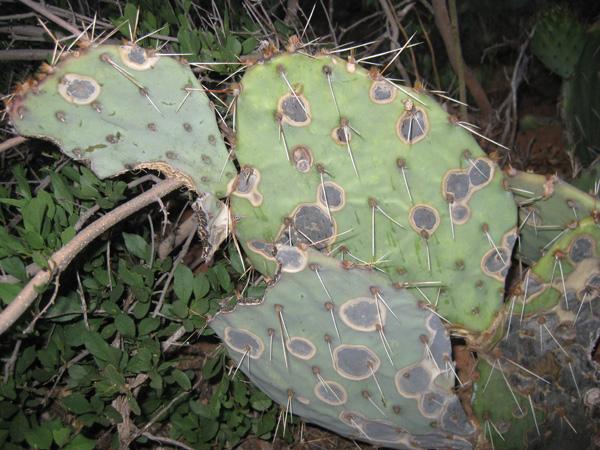
Phyllosticta Symptoms in Prickly Pears
Prickly pear leaf spot is a disease of that plant and others in the Opuntia family. The disease is brought about by tiny spores from the Phyllostica fungus. These colonize on the tissues, primarily the pads, of the cactus and eat into it causing lesions. There is no recommended treatment for Phyllosticta fungus, but it can spread to other ornamental plants and removal of infected pads and plant material is suggested to prevent the disease from reaching other species.
In the cactus family, prickly pears are most affected by Phyllosticta concava. The disease is also called dry rot because it leaves lesions on the plant, which eventually callus and do not weep fluid like other fungal diseases. The disease starts out with dark, almost black, irregularly circular lesions which that in size from 1 to 2 inches in diameter. Tiny reproductive structures, called pycnidia, produce the dark color. These produce and release the spores which can infect other plants. As conditions change, the spots will fall out of the cactus and the area will callus over, leaving scars on the pads. No serious damage is done, provided the weather conditions transition to warm and dry.
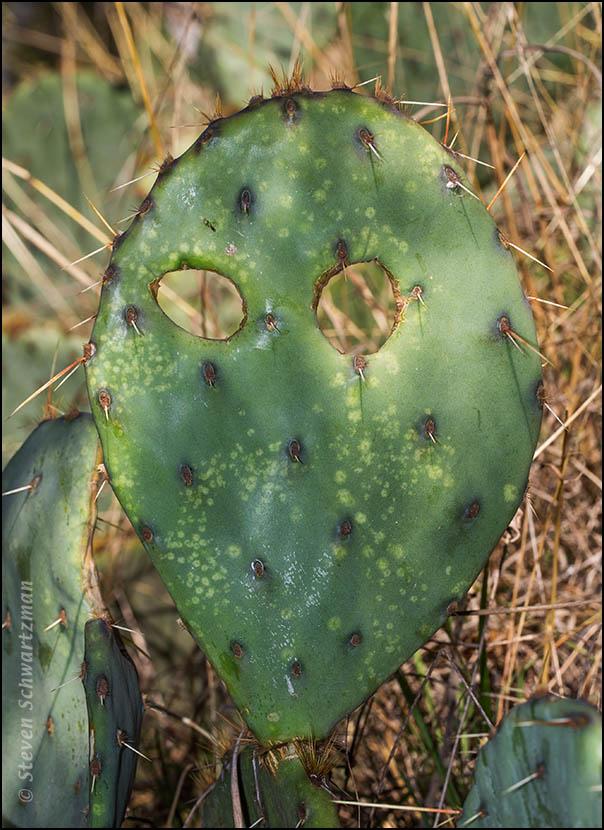
Phyllostica Control in Cactus
For the most part, prickly pear leaf spot does not harm the plants but it is contagious and it does damage young pads the most. Lower pads are the most severely affected, as these are close to the ground. The spores spread through wind or splashing activity. The disease is active during the rainy season and where humidity is high. Once the weather changes to dry conditions, the fungus becomes inactive and falls out of the plant tissue. Severely affected tissue can develop many lesions, making way for the introduction of other pathogens and insects which can cause more damage than prickly pear leaf spot. Experts do not recommend fungicide or any other treatment for Phyllosticta fungus. This is probably due to the fact that the fungus is short acting and weather conditions usually improve, deactivating the disease. Additionally, the fungus doesn’t appear to impair the plant in most cases.
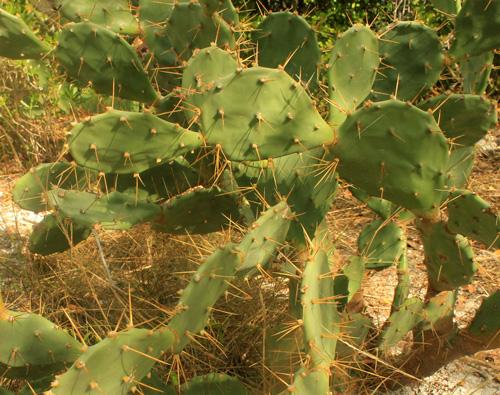
Suggested Phyllosticta control in cactus is removal of infected parts. This is the case where pads have been invaded by numerous lesions and the numerous fruiting bodies pose an infection potential to the rest of the plant and surrounding species. Composting the infected plant material may not kill the spores. Therefore, bagging and discarding the pads is advised.

Phyllosticta Symptoms in Prickly Pears
Prickly pear leaf spot is a disease of that plant and others in the Opuntia family. The disease is brought about by tiny spores from the Phyllostica fungus. These colonize on the tissues, primarily the pads, of the cactus and eat into it causing lesions. There is no recommended treatment for Phyllosticta fungus, but it can spread to other ornamental plants and removal of infected pads and plant material is suggested to prevent the disease from reaching other species.
In the cactus family, prickly pears are most affected by Phyllosticta concava. The disease is also called dry rot because it leaves lesions on the plant, which eventually callus and do not weep fluid like other fungal diseases. The disease starts out with dark, almost black, irregularly circular lesions which that in size from 1 to 2 inches in diameter. Tiny reproductive structures, called pycnidia, produce the dark color. These produce and release the spores which can infect other plants. As conditions change, the spots will fall out of the cactus and the area will callus over, leaving scars on the pads. No serious damage is done, provided the weather conditions transition to warm and dry.

Phyllostica Control in Cactus
For the most part, prickly pear leaf spot does not harm the plants but it is contagious and it does damage young pads the most. Lower pads are the most severely affected, as these are close to the ground. The spores spread through wind or splashing activity. The disease is active during the rainy season and where humidity is high. Once the weather changes to dry conditions, the fungus becomes inactive and falls out of the plant tissue. Severely affected tissue can develop many lesions, making way for the introduction of other pathogens and insects which can cause more damage than prickly pear leaf spot. Experts do not recommend fungicide or any other treatment for Phyllosticta fungus. This is probably due to the fact that the fungus is short acting and weather conditions usually improve, deactivating the disease. Additionally, the fungus doesn’t appear to impair the plant in most cases.

Suggested Phyllosticta control in cactus is removal of infected parts. This is the case where pads have been invaded by numerous lesions and the numerous fruiting bodies pose an infection potential to the rest of the plant and surrounding species. Composting the infected plant material may not kill the spores. Therefore, bagging and discarding the pads is advised.
0
0
文章
Dummer. ゛☀
2017年08月27日

Growing pincushion cactus is an easy gardening project for the novice gardener. The plants are drought tolerant and native to the arid upper Sonoran desert. They are small cacti that make excellent additions to succulent displays. Pincushion cactus plant is a perennial that is most often found in heavily grazed pastureland and woody scrub.

Pincushion Cactus Plant Varieties
Pincushion cactus is a member of a family called Mammillaria, which includes 250 species of cactus. Some of the species of pincushion have colorful names. The Giant Snake or Crawling Log cactus (Mammillaria matudae) produce long stems. Snowball cushion cactus (Mammillaria candida) is a ball-shaped plant with white felt or fuzz on the skin of the plant. Old Lady cactus (Mammillaria hahniana) is a solitary cactus with white fuzzy hair-like spines and purplish red flowers. There are also Powder puff (Mammillaria bocasa-na) and Rose (Mammillaria zeilmanniana) among many others. Cactus and succulent stores can provide you with more pincushion cactus information.

Pincushion Cactus Information
Pincushion cacti are small, squat plants that usually don’t grow more than 6 inches in height. They can be ball or barrel shaped, and are native to the warmer regions of the United States. The pincushion cactus plant is most commonly grown indoors but it can tolerate some chilling temperatures if grown outside. Pincushion cactus is so called because it is covered in white spines over the entire surface of the plant. It is a very prickly little specimen that is best handled with thick gloves.
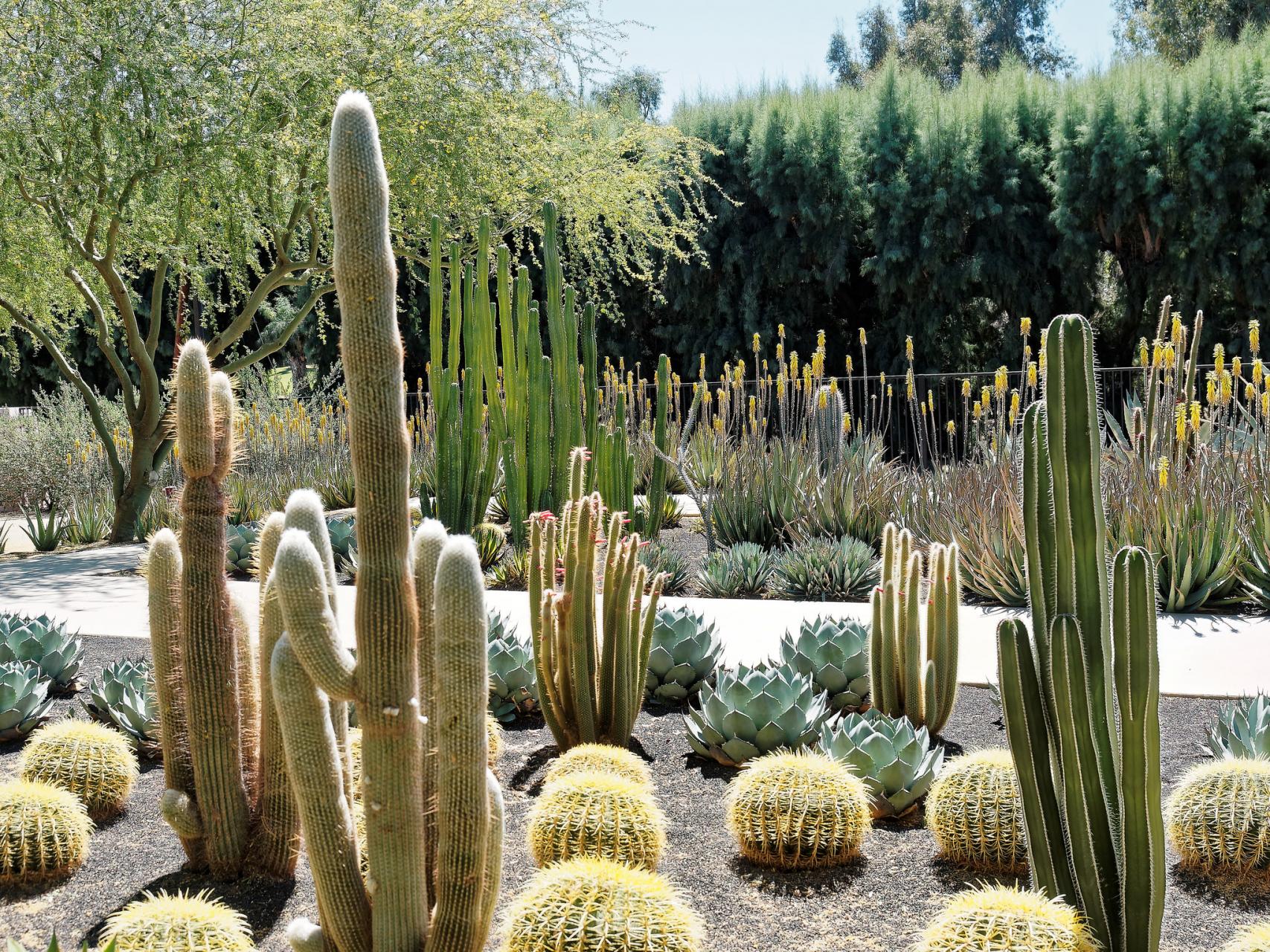
Growing Pincushion Cactus
Pincushion cactus care is very simple and suitable for the beginning gardener. Cactus plants are used to dry conditions and limited fertility. The soil for a pincushion needs to be well drained and gritty. The soil needs to dry out between watering, which is best accomplished with a sandy topsoil. The cactus goes dormant in winter and needs no additional irrigation until spring. Potted plants do well in unglazed clay pots, which allow any extra moisture to evaporate. Temperatures should be between 50 and 75 F. (10-24 C.). Small gravel spread around the base of the plant out to the root zone will act as a mulch to deter stem rot. The cactus produces offsets when it is mature. These can be divided from the mother plant and potted in a sandy soil mixture. You can also start the plants from seed in spring. Plant seed in a flat filled with cactus mix. Surface sow and then sprinkle sand lightly over the top and moisten the soil evenly. Place the flat in a warm location of at least 70 F. (21 C.). Keep seeds wet when growing pincushion cactus. Seedlings are transplanted when they can easily be moved.
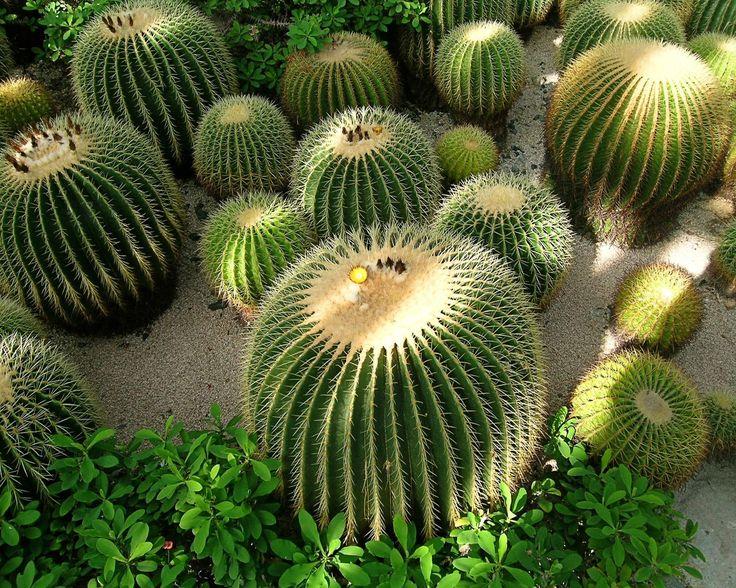
Flowering Pincushion Cactus
If optimum heat and watering conditions are met, the pincushion cactus may reward you with flowers in spring. Enhance the chance of blooming by holding off watering until several weeks into spring. You can also apply a cactus food in early spring to give the plant the nutrients it needs to produce blooms.

Pincushion Cactus Plant Varieties
Pincushion cactus is a member of a family called Mammillaria, which includes 250 species of cactus. Some of the species of pincushion have colorful names. The Giant Snake or Crawling Log cactus (Mammillaria matudae) produce long stems. Snowball cushion cactus (Mammillaria candida) is a ball-shaped plant with white felt or fuzz on the skin of the plant. Old Lady cactus (Mammillaria hahniana) is a solitary cactus with white fuzzy hair-like spines and purplish red flowers. There are also Powder puff (Mammillaria bocasa-na) and Rose (Mammillaria zeilmanniana) among many others. Cactus and succulent stores can provide you with more pincushion cactus information.

Pincushion Cactus Information
Pincushion cacti are small, squat plants that usually don’t grow more than 6 inches in height. They can be ball or barrel shaped, and are native to the warmer regions of the United States. The pincushion cactus plant is most commonly grown indoors but it can tolerate some chilling temperatures if grown outside. Pincushion cactus is so called because it is covered in white spines over the entire surface of the plant. It is a very prickly little specimen that is best handled with thick gloves.

Growing Pincushion Cactus
Pincushion cactus care is very simple and suitable for the beginning gardener. Cactus plants are used to dry conditions and limited fertility. The soil for a pincushion needs to be well drained and gritty. The soil needs to dry out between watering, which is best accomplished with a sandy topsoil. The cactus goes dormant in winter and needs no additional irrigation until spring. Potted plants do well in unglazed clay pots, which allow any extra moisture to evaporate. Temperatures should be between 50 and 75 F. (10-24 C.). Small gravel spread around the base of the plant out to the root zone will act as a mulch to deter stem rot. The cactus produces offsets when it is mature. These can be divided from the mother plant and potted in a sandy soil mixture. You can also start the plants from seed in spring. Plant seed in a flat filled with cactus mix. Surface sow and then sprinkle sand lightly over the top and moisten the soil evenly. Place the flat in a warm location of at least 70 F. (21 C.). Keep seeds wet when growing pincushion cactus. Seedlings are transplanted when they can easily be moved.

Flowering Pincushion Cactus
If optimum heat and watering conditions are met, the pincushion cactus may reward you with flowers in spring. Enhance the chance of blooming by holding off watering until several weeks into spring. You can also apply a cactus food in early spring to give the plant the nutrients it needs to produce blooms.
1
1





